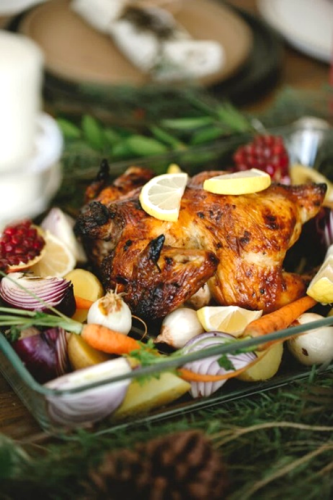By Anne Hogan
The winter holidays are just around the corner, and many of us are preparing to make our favorite holiday dishes. As you plan your menu, keep in mind all the creative and delicious ways you can increase the nutritional value of your meals. Some ideas include:
Using Colorful Vegetables:
According to the USDA, it is best to consume a diet with a variety of vegetables, including dark green, red/orange, beans, and starchy types. Examples could include foods such as broccoli, spinach, carrots, cauliflower, white potatoes, and many more (Dietary Guidelines, 2020). This holiday season, consider incorporating vegetables into your food to add color and nutrients to your holiday favorites.
Substituting with Low-Fat Options:
While many traditional holiday dishes are high in fat, you can remedy this by making substitutions. For example, try using reduced-fat or fat-free varieties when cooking with cheese. In several recipes, you can also use plain-fat-free yogurt instead of sour cream. Finally, try using applesauce in place of oil, butter, and margarine in baked goods such as cookies, brownies, muffins, and some quick breads (Eat Right, 2021).
*Note: If substituting yogurt for sour cream, make sure the label says “plain” and not “vanilla”!
Adding Fiber:
Fiber is a plant component that aids in proper digestion. Common foods that are high in fiber include fruits such as apples and pears, vegetables like peas and broccoli, grains such as whole-wheat bread and pasta, as well as nuts and beans (Mayo Clinic, 2021). Many of these foods can be added as sides, or even stand-alone dishes, at your holiday gathering.
Reducing Added Sugars:
Many desserts, including your favorite holiday cookies, can still taste amazing if made with 1/3 less sugar than the amount listed in the recipe. Additionally, fresh fruit and canned fruit packed in water can add natural sweetness and flavor in place of traditional sugar (UnlockFood.ca, 2018).
Summary:
There are numerous ways to make a holiday menu that is delicious and nutritious, both during the holidays and beyond. Making small adjustments to your favorite recipes by adding various vegetables, using low-fat ingredients, adding fiber, and reducing added sugars can significantly improve the nutritional value of your meals.
For more information on eating balanced meals, use the MyPlate guidelines published by the USDA (MyPlate, 2020).
References:
- Eat Right (2021, October). Helpful tips for healthy holiday parties. Academy of Nutrition and Dietetics. https://owl.purdue.edu/owl/research_and_citation/apa_style/apa_formatting_and_style_guide/reference_list_electronic_sources.html
- Mayo Clinic Staff (2021, January 5). Nutrition and healthy eating: Chart of high-fiber foods. Mayo Clinic. https://www.mayoclinic.org/healthy-lifestyle/nutrition-and-healthy-eating/in-depth/high-fiber-foods/art-20050948
- United States Department of Agriculture (USDA), (2020). Dietary Guidelines for Americans, 2020-2025. 9th Ed. Retrieved from https://www.dietaryguidelines.gov/sites/default/files/2021-03/Dietary_Guidelines_for_Americans-2020-2025.pdf
- United States Department of Agriculture (USDA), (2020). Start simple with MyPlate today. Retrieved from https://www.dietaryguidelines.gov/sites/default/files/2021-03/DGA_2020-2025_StartSimple_withMyPlate_English_color.pdf
- UnlockFood.ca (2018, May 10). Recipe makeover: Reducing sugar in the kitchen. Dietitians of Canada. https://www.unlockfood.ca/en/Articles/Carbohydrate-and-Sugar/Recipe-Makeover-Reducing-Sugar-in-the-Kitchen.aspx#:~:text=Up%20to%201%2F3%20of,needed%20to%20activate%20the%20yeast
Anne Hogan is a Graduate Student in Food Science and Human Nutrition at the University of Illinois at Urbana Champaign
Image by Tim Douglas from Pexels













